While still deeply attached to its history, today London is grappling with rapid population growth. The ensuing need to increase density in appropriate areas and improve connectivity present London with challenges of a quintessentially modern kind.
In this city of 200 consolidated villages, growth is now governed by one document: the London Plan. As deputy mayor for policy and planning, as well as the mayor’s chief of staff, Sir Edward Lister must manage a host of variables in quadrennial updates to the London Plan.
Lister recently spoke with The Planning Report while visiting Los Angeles for the CityAge LA conference. He commented on the most recent London Plan, which reflects the city's contemporary concerns: density and connectivity.
The plan identifies "opportunity areas" in need of revitalization, where the city hopes to densify and build affordable housing on brownfield land. And "the key to lifting up those areas is opening up transport," Sir Lister says.
Lister also notes the success of London's dual response to traffic as the city grows: implementing congestion pricing, and creating parking maximums based on connectivity to transit in the area.
How these planning, development, and transportation functions get funded, however, is an increasingly pressing question—and one that the States might help answer. "We watch very closely what happens in the US," Sir Lister notes. "You’ve had to do what we’re now having to do: find other ways of raising money to build infrastructure. You have a much more flexible system, which has allowed you to raise cash to bring about the changes you need through TIF and levies. We are quite interested in your funding mechanisms."
FULL STORY: City Planning That Values Stewardship: Implementing the London Plan

Study: Maui’s Plan to Convert Vacation Rentals to Long-Term Housing Could Cause Nearly $1 Billion Economic Loss
The plan would reduce visitor accommodation by 25,% resulting in 1,900 jobs lost.

North Texas Transit Leaders Tout Benefits of TOD for Growing Region
At a summit focused on transit-oriented development, policymakers discussed how North Texas’ expanded light rail system can serve as a tool for economic growth.

Why Should We Subsidize Public Transportation?
Many public transit agencies face financial stress due to rising costs, declining fare revenue, and declining subsidies. Transit advocates must provide a strong business case for increasing public transit funding.

How to Make US Trains Faster
Changes to boarding platforms and a switch to electric trains could improve U.S. passenger rail service without the added cost of high-speed rail.

Columbia’s Revitalized ‘Loop’ Is a Hub for Local Entrepreneurs
A focus on small businesses is helping a commercial corridor in Columbia, Missouri thrive.

Invasive Insect Threatens Minnesota’s Ash Forests
The Emerald Ash Borer is a rapidly spreading invasive pest threatening Minnesota’s ash trees, and homeowners are encouraged to plant diverse replacement species, avoid moving ash firewood, and monitor for signs of infestation.
Urban Design for Planners 1: Software Tools
This six-course series explores essential urban design concepts using open source software and equips planners with the tools they need to participate fully in the urban design process.
Planning for Universal Design
Learn the tools for implementing Universal Design in planning regulations.
City of Santa Clarita
Ascent Environmental
Institute for Housing and Urban Development Studies (IHS)
City of Grandview
Harvard GSD Executive Education
Toledo-Lucas County Plan Commissions
Salt Lake City
NYU Wagner Graduate School of Public Service





























